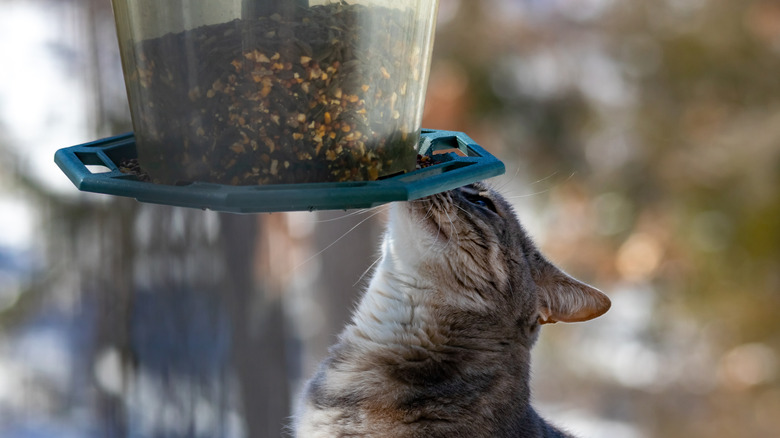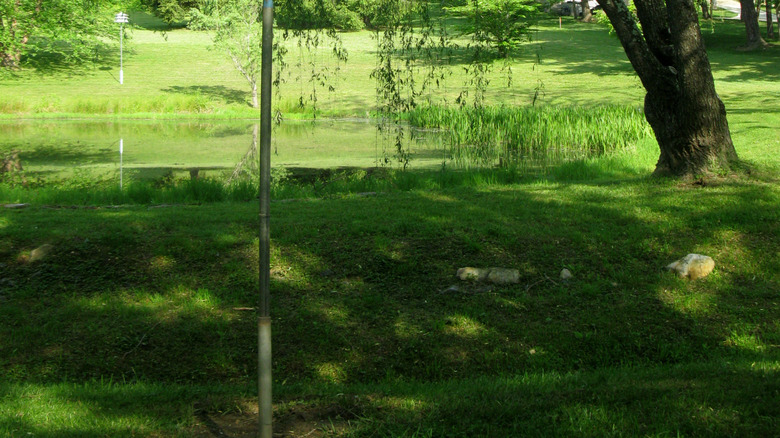Keep Cats Away From Your Bird Feeders With These Simple Tips
We may receive a commission on purchases made from links.
Cats are instinctively drawn to birds due to their predatory nature. Even indoor cats that have never hunted can become mesmerized by a robin perched right outside a window or hummingbird fluttering above a garden. If you have a bird feeder and a cat that spends time outside, your cat has definitely noticed. It's probably also learned that its bird-snatching odds increase if it stays close to it. This doesn't mean that the two animals can't share the same space at the same time, however. All you have to do is make a few adjustments to prevent your cat from accessing the feeder. For example, you can relocate the feeder or use a cat deterrent.
Even if you don't own a feline, following these tips can help protect birds from any neighborhood cats that spend time in your yard. Bird watching provides several benefits for humans, including stress reduction. Installing a feeder is also a great way to enrich your cat's environment — your indoor cat, that is — so continue welcoming birds to your yard while taking extra measures to keep them safe.
Be strategic about the location of the bird feeder
If a cat can't access a bird feeder it won't be able to access the birds eating from it. As exceptional hunters, cats are good at hiding, stalking, and sneaking before pouncing at the perfect moment. One place they love to hide is behind tall grass and bushes. The farther away these hiding spots are from the feeder, the lower the odds are that a cat will succeed in capturing a bird feeding from it. If possible, ensure there is at least 12 feet of empty space between bushes or tall grass and the feeder.
Instead of focusing on the horizontal location of the feeder, consider the vertical as an alternate option. On average, cats can jump 6-8 feet high, so if you're able to securely hang the feeder, aim for a height of at least 8 feet. You should also ensure there are no objects nearby close enough for a cat to climb and jump on the feeder. Remember, cats can climb just as well as they can jump, and they often do one if they can't do the other.
Use a barrier or deterrent to keep cats away
Another way to prevent a cat's access to your backyard bird feeder is by creating a barrier or an audible or physical deterrent. The barrier could be in the form of spiny plants or sharp-edged gravel, with the goal of creating an unpleasant or inaccessible environment for a cat. Once a cat comes in contact with these plants or feels the gravel under its paws, it will be more likely to leave the bird feeder area. Cats have soft paw pads, so walking on sharp gravel would be the equivalent of you doing the same barefoot.
A deterrent can also be effective in keeping cats away from your bird feeder. If you have any experience with bathing a cat, you know it's one of the things people do that cats hate. That's why deploying a motion-activated sprinkler, like TruRid's Motion Activated Sprinkler, near the bird feeder is likely to keep them and other predators away. Cats aren't too fond of high-frequency sounds either. With that in mind, consider setting up an ultrasonic deterrent device that emits high-frequency sounds that are inaudible to humans and birds. Cats can hear up to 64 kHz while birds can typically hear up to 4 kHz, and humans can hear up to 20 kHz.
You probably won't ever cause a cat to lose interest in a small flying prey, but at least you'll be able to thwart all of its efforts to capture it by using one or more of these tips. The birds will thank you for it.


